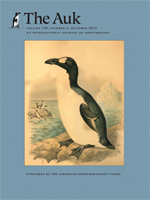Joining other textbooks on community ecology by Morin (2011, Wiley-Blackwell), Putnam (1994, Kluwer Academic), and Kikkawa and Anderson (1986, Blackwell Scientific), plus several edited books on the subject, Mittelbach's Community Ecology has a distinct tilt toward aquatic ecology, reflecting the author's area of expertise. Despite the importance of birds in the historical and current development of community ecology, this book has relatively few avian examples. Its 16 chapters are organized in five parts on contemporary community ecology and recent advances such as metacommunities, community phylogenetics, and the growing importance of molecular biology.
The first chapter describes the evolution of community ecology from Forbes, Clements, Gleason, and Elton to Lotka, Volterra, Gause, Hutchinson, and MacArthur. The debates over the importance of interspecific competition, null models, and new directions such as meta-analysis are included to introduce diversity in theory and differing schools of thought. Other than a brief comment about Forbes, community ecology before the 1900s is not mentioned. Two chapters in Part I concentrate on “the big picture” of patterns of biological diversity and ecosystem functioning. They include hypotheses to explain latitudinal diversity gradients, spatial scales of diversity (citing one of the few bird examples), species–area and species-abundance relationships, as well as ecosystem productivity, stability, and invasibility. Chapter 3 explores two powerful questions: Can ecologists predict the consequences of biodiversity loss, and how many species do we need to ensure that ecosystems continue to function normally? Because biodiversity loss and changing ecosystems are important and relevant issues, this is effective in assuring the reader that the book is current and significant.
Part II includes six chapters on population growth, density dependence, predator-prey interactions, selective pressures, interspecific competition, and beneficial interactions. Most readers are likely familiar with these concepts from introductory ecology textbooks. Most of the chapters in this section are heavily laden with equations and theoretical figures but lack empirical examples from actual ecological scenarios. The later chapters in this section provide some examples, though primarily for plants or aquatic ecosystems. Examples on birds are few but include optimal diet studies of Great Tits (Parus major), altitudinal niche shifts of birds in New Guinea, and the classic example of adaptive radiation and character displacement in Darwin's finches. This section includes witty quotations on such subjects as the paradigm shift from an equilibrium to a non-equilibrium view of ecology. These add levity and give the reader a taste of personality behind the citations. The last chapter in the section is a refreshing follow-up to the previous chapters, largely dedicated to predation and competition. It emphasizes the beneficial effects and apparent ubiquity of species interactions observed in nature.
Part III consists of two chapters focused on ecological networks, food chains, and food webs. The section provides a solid overview for readers new to these subjects, with well-illustrated figures. The examples included are primarily from aquatic ecosystems, including one example on the interaction between predator and prey sizes for birds in rocky intertidal areas.
Part IV includes two chapters on spatial ecology in which patchy environments, metapopulations, metacommunities, and neutral theory are emphasized. The chapters provide an adequate introduction to the theoretical concepts associated with community dynamics within patchy environments, but a greater emphasis on terrestrial landscapes would have provided a better balance in conjunction with the examples from laboratory and aquatic studies.
Part V concludes with three chapters on species in changing environments, emphasizing species coexistence and evolutionary community ecology. Mittelbach's final remarks on the future of community ecology include many thought-provoking avenues for advancement in community ecology through niche-based or neutral processes and the application of phylogenetics. The book concludes with a potpourri of ideas to ponder, from the integration of local and regional processes to the potential importance of understudied pathogens and parasites to the impacts of climate change on communities.
The first words of the book are “What to leave in, what to leave out?” This is certainly a challenge in any attempt to write a book on a subject as broad as community ecology that also has a reasonable length and price. Mittelbach has met the challenge of length and price; however, a broader and more balanced selection of citations would improve the book. For instance, there are 34 lead-author citations of Abrams, 22 of Tilman, 13 of Chesson, 12 of May, and 11 of Mittelbach himself. These individuals have all contributed substantially to community ecology, but many superb contributions by ornithologists have been omitted.
The broader question remains whether the book adequately represents the field of community ecology. It achieves an integration of aquatic-oriented studies into community ecology, but its usefulness to ornithologists will be limited even though studies of birds have long contributed to theoretical and applied advancements in community ecology. A better title would be “A Community Ecology Primer, with Special Emphasis on Aquatic Communities.” The book fails to advance an understanding of the importance of biodiversity loss and its consequences to ecosystem functioning. It also fails to explain the difficulty of obtaining data to adequately test the many theoretical ideas presented. Finally, we found numerous grammatical and spelling errors, though overall the book is well written.
Mittelbach's Community Ecology belongs in the libraries of major universities, selected organizations with aquatic-oriented programs, and individuals who consider themselves community ecologists with an aquatic emphasis. We read and critically reviewed this book as part of a graduate seminar course on community ecology.





